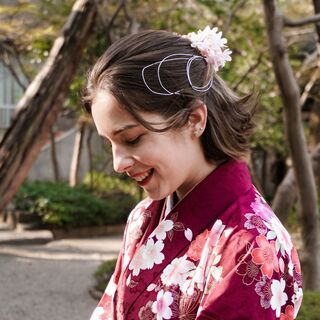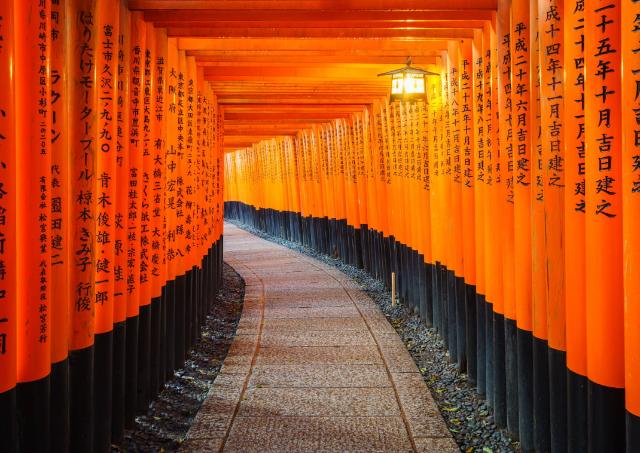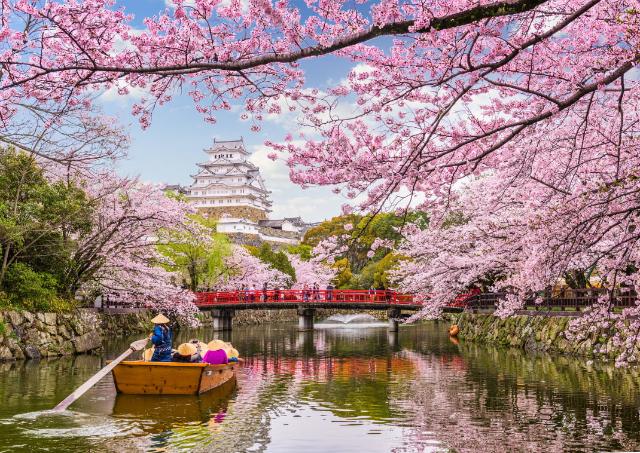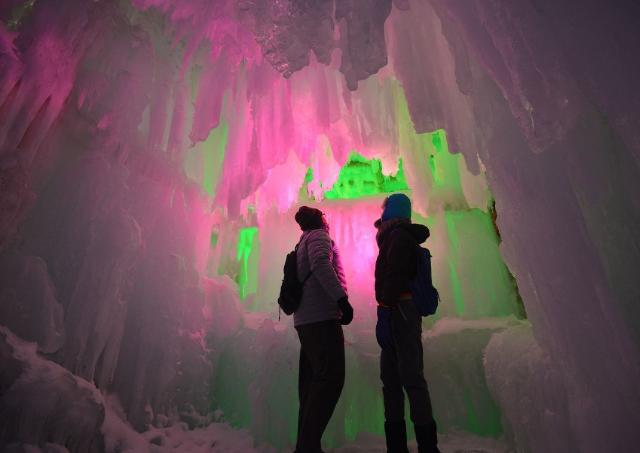How to Decide the Best Time of Year to Visit Japan

Japanspecialist
Budapest, Hungary
On a first trip to Japan, it can be tempting to go with the most popular option and visit during the cherry blossom season, but that may not be the perfect time for you! Let’s take a look at what to expect from the weather, scenery, and crowds in each season.
Japan has a well-known affection for the change of the seasons, and for good reason. Each season has its own distinct characteristics and highlights, from summer festivals to the snowy scenes of winter. It’s fun to see the different sides of Japan and the culture that comes along with it.
So, depending on what you’re looking for out of your Japan trip, you might find that winter would be perfect but summer is not for you! Here we’ll look at an overview of the advantages and disadvantages of a trip to Japan in each season. Remember that weather can vary quite a lot between Japan’s northern and southern regions, so we’ll use Tokyo as a middle ground, but after getting an idea, be sure to look into more detail of the regions you’re interested in!
Table of Contents:
- Japan’s Climate and Geography
- Understanding Japan’s Seasons
- Spring
- Summer
- Autumn
- Winter
- Seasonal Activities
- Holidays and Festivals
- The Best Time to Visit Japan
Overview of Japan’s Climate and Geography
Japan is an archipelago of over 6,800 islands, stretching from the northernmost tip of Hokkaido to the southernmost tip of Okinawa. This diverse geography means that Japan experiences a wide range of climates and microclimates. The country is characterized by its mountains, forests, and coastlines, offering a stunning variety of landscapes. Japan enjoys four distinct seasons: spring, summer, autumn, and winter. Each season brings its own unique charm and activities, making Japan a year-round destination. In the north, Hokkaido is known for its cold winters and mild summers, perfect for winter sports and summer hiking. Meanwhile, the southern island of Okinawa boasts a subtropical climate, ideal for beach lovers and water sports enthusiasts.
Understanding Japan’s Seasons
Japan’s seasons play a significant role in determining the best time to visit. Spring, from March to May, is a favourite among travellers due to the mild temperatures and the breathtaking cherry blossom season. This is the time when the country is awash with pink and white blossoms, creating picturesque scenes perfect for photography and leisurely strolls. Summer, from June to August, is hot and humid, with temperatures often soaring above 30°C (86°F). Despite the heat, summer is vibrant with festivals and beach activities. Autumn, from September to November, offers comfortable temperatures and stunning autumn foliage, making it an excellent time for hiking and exploring temples. Winter, from December to February, brings cold weather, especially in the north, where temperatures can drop below 0°C (32°F). This season is perfect for skiing, snowboarding, and enjoying hot springs.
Japan in Spring (March-May) :
Spring is arguably the best time to go: Japan enters the iconic cherry blossom season, and the country comes alive with spring colours. These beautiful blooms create picturesque scenes across the country, making it a must-see for travellers.
During this time, the weather is typically mild, with temperatures in Tokyo ranging from 13-23°C (55-73°F). Spring is the most reliably sunny season, with clear and sunny skies before the summer months arrive. Cherry blossoms generally start blooming in late March in central Japan, while northern areas see their blossoms in mid to late April.
However, if you prefer fewer crowds, spring may not be ideal. April is often the most popular month for visitors, coinciding with Golden Week (April 29-May 6), when many locals travel. To avoid the crowds, consider visiting less popular parks or remote areas. Alternatively, visiting Japan in winter allows you to see the early plum blossoms instead.
In summary, spring offers stunning sights and pleasant weather but can be crowded, so plan accordingly to enjoy your time in Japan.
March
March marks the beginning of spring in Japan, and while it is still chilly, some cherry blossoms will start blooming towards the end of the month. Early March is an excellent time to visit for those looking to enjoy early blooming cherry blossoms without the overwhelming crowds and higher prices of peak season. Spring is also the season for strawberries, so look out for delicious strawberry drinks and cakes, or even find a place to go strawberry picking! This is also the month of Girls’ Day, or Hina matsuri, so many shrines will adorn different areas with hand-crafted dolls.
Specific events to look out for:
Omizutori, Nara. March 1-14. A 1,200-year-old Buddhist ceremony at Todai-ji Temple, involving torch-lit processions and the drawing of sacred water.
Strawberry picking at Ichigo no Sato Farm, Tochigi. From February onwards.
Hinamatsuri (Doll Festival), Nationwide. March 3. A festival where families display dolls and pray for the health and happiness of girls.
Katsuura Big Doll Festival, Chiba. February dates change annually. A Doll Festival featuring up to 7,000 hina dolls.
Takayama Spring Festival, Gifu. Late March to Early April. One of Japan’s most beautiful festivals, with elaborate floats and street performances celebrating the arrival of spring.
Saga Balloon Festival, Saga. Late March. A hot air balloon festival that brightens the skies of Saga, with hundreds of balloons taking flight.
April
April is peak cherry blossom season in Japan, which means a ton of festivals, hanami celebrations, and merriment surrounding the season. The first week of April is often when cherry blossoms reach their peak bloom, making it an ideal time for travellers hoping to see the iconic blooms - here are our top 5 cherry blossom spots. Generally speaking, this is the first month of warm and sunny weather, but it is known to be warm one day and cold and rainy the next! This is also a good month for other flowers, like wisterias, nemophilas and azaleas, too.
Specific events to look out for:
Miyako Odori, Kyoto. April 1-30. A graceful dance performance by geisha and maiko in Kyoto’s Gion district, showcasing traditional Japanese arts.
Nakameguro Cherry Blossoms, Tokyo. Late March to early April.
Yayoi Festival, Nikko, Tochigi. Mid-April. Beautifully decorated floats celebrating the arrival of spring in Nikko.
Kakunodate Cherry Blossom Festival, Akita. Mid to Late April. Cherry blossoms in the historic samurai district of Kakunodate, famous for its beautiful sakura.
Blue nemophila flowers at Hitachi Seaside Park, Ibaraki. Mid-April to early May.
The Great Wisteria Festival at Ashikaga Flower Park, Tochigi. Mid-April to mid-May.
May - Golden Week
May is the transition period between spring and summer, where it’s starting to get hot but no-one has invited the rain clouds, yet! The beginning of the month is Golden Week, a series of national holidays where every local is travelling, so it is best to avoid that time if you can, as attractions and accommodation will be crowded. But it is also the month when lots of festivals are happening, and some towns are decorated with carp streamers for Children’s Day.
Specific events to look out for:
Tokyo Skytree Town Koinobori Festival, Tokyo. Children’s Day, May 5 (during Golden Week).
Kanda Matsuri, Tokyo. Mid-May (Odd-numbered years). One of Tokyo’s biggest festivals, featuring grand parades and portable shrines.
Mifune Matsuri, Kyoto. Mid-May. A festival in Arashiyama where ancient boats are sailed down the Oi River, re-enacting imperial court scenes.
Aoi Matsuri, Kyoto. May 15. A historic festival with a parade of people dressed in Heian-period clothing, travelling between Kyoto's biggest shrines.
Sanja Matsuri, Asakusa, Tokyo. Late May. A lively festival in Asakusa with massive parades and portable shrines honouring the founders of Senso-ji Temple.
Japan in Summer (June-August):
Summer in Japan may not be ideal for those heading to the main island due to intense heat and humidity. However, it’s a pleasant time to explore northern regions.
One of the highlights of a summer trip is the lush greenery throughout the country. While Tokyo and southern areas often exceed 30°C (86°F), northern destinations like Hokkaido and Tohoku remain cooler. Hokkaido is perfect for summer visits, featuring beautiful spots like Tomita Lavender Farm and delicious local soft-serve ice cream. Summer also brings vibrant festivals and fireworks nationwide - here are 10 fun things to do!
If you're seeking a beach holiday or visiting popular cities like Tokyo and Kyoto, summer might not be the best option. The rainy season typically begins in June and lasts until early July, bringing heat and humidity on non-rainy days. While air conditioning is prevalent indoors, prolonged outdoor stays can be risky due to the heat.
In summary, summer can be very hot in southern Japan but offers a cooler and beautiful experience up north. For a beach getaway, consider visiting southern regions like Okinawa in spring or autumn.
June
Rainy season tends to hit hard during June, so expect a lot of hot and wet days! June falls within Japan's off-peak season, offering fewer crowds, and lower travel costs for those not focused on peak attractions like cherry blossom viewing. The best way to tackle June in Japan is to plan a lot of indoor activities, with some back-up sunny day activities. You can still do rainy day activities if it’s sunny, but not really the other way around! This is a good month to explore some of Japan’s cultural side, such as by seeing a Kabuki or Noh play, visiting art galleries and museums. Or visit one of the many aquariums or shopping malls.
When you do come across sunny days, all that rain makes for beautiful blossoms, too. So look out for lavender and hydrangea in June.
Specific events to look out for:
Hydrangea Festivals, in Bunkyo Ajisai Matsuri, Hakusan Shrine, Tokyo. Or at temples such as Meigetsuin Temple, Kamakura, Kanagawa. Early-mid June.
Chagu Chagu Umakko Horse Festival, Iwate. Early to Mid-June. A colourful horse parade with 100 beautifully decorated horses celebrating local farming traditions.
Sanno Matsuri, Tokyo. Early to Mid-June (Even-numbered years). One of Tokyo’s major Shinto festivals, featuring processions of portable shrines around the city.
Lavender and flowers at the Lake Kawaguchi Herb Festival, Oishi Park, Yamanashi. June to July.
Fujisan Climbing Season Opening, Mt. Fuji. Late June. The official opening of the climbing season for Japan’s most iconic mountain, with ceremonies and prayers for safety.
July
July is when summer is in full swing. That means a lot of festivals, from floats and parades to summer fireworks. In main areas like Tokyo, this is also the time to celebrate Tanabata, the star festival that brings with it colourful streamers and summer wind chimes. This is also the start of the Mt Fuji climbing season.
Specific events to look out for:
Gion Matsuri, Kyoto. Entire month of July, with main events on July 17 and 24. One of Japan’s most famous festivals, featuring massive floats parading through Kyoto.
Shitamachi Tanabata Festival, Tokyo. July 6-7. Celebrating the meeting of two lovers (stars) on Tanabata's Eve.
Mitama Matsuri, Tokyo. Mid-July. A lantern festival held at Yasukuni Shrine, featuring thousands of lanterns to honour the spirits of the deceased.
Sumida River Fireworks, Tokyo. Late July. A dazzling fireworks display along the Sumida River that attracts huge crowds.
Tenjin Matsuri, Osaka. July 24-25. A lively festival with a river procession of boats and vibrant fireworks.
August
August is the month of Obon, a Buddhist festival commemorating ancestors mainly from August 13-16. This month brings with it more festivals and dancing, as well as cooling summer foods like kakigori, and fun outdoor activities like hiking, canyoning and water sports.
Specific events to look out for:
Nebuta Matsuri, Aomori. August 2-7. A spectacular parade of illuminated, warrior-shaped floats that light up the streets of Aomori.
Sendai Tanabata Festival, Sendai. August 6-8. Japan’s largest Tanabata festival, with stunning paper decorations hanging throughout the city.
Awa Odori Festival, Tokushima. August 12-15. Japan’s largest traditional dance festival, where thousands of dancers parade through the streets performing lively folk dances.
Bon Odori, Nationwide. Mid-August. A traditional dance to honour the spirits of ancestors, celebrated in parks and temples across Japan.
Daimonji Festival, Kyoto. August 16. Enormous bonfires lit on Kyoto's surrounding hills.
Koenji Awa Odori, Tokyo. Late August. The Tokyo version of the Tokushima Awa Odori Festival.
Japan in Autumn (September-November):
Autumn in Japan rivals spring's beauty, showcasing stunning fall foliage in vibrant reds and oranges. While early autumn coincides with typhoon season, late autumn offers a serene escape with fewer crowds, making it perfect for capturing picturesque moments without the rush of cherry blossom season. Traditional Japanese architecture harmonizes beautifully with the autumn colours, providing scenic backdrops for visiting shrines and temples. As the weather cools, it remains above 20°C until late October, dropping to around 10-17°C in November in Tokyo, making it a comfortable time to explore.
Despite the potential for typhoons from late August to early September, which can bring heavy rain and winds, October and November see Japan burst into colour, especially in popular tourist attractions. Enjoy cultural experiences like the Takayama Autumn Festival, as well as relaxing in onsen (hot spring) baths - even with your partner - surrounded by beautiful autumn leaves. You can also experience Japan's gardens where the fall colours shine.
Plan your visit to align with peak foliage in various regions for the ultimate autumn experience. Whether you're exploring the Japanese Alps or seeking quieter off-peak season adventures (such as Tohoku), autumn offers a unique opportunity to appreciate Japan's four distinct seasons and the beauty of its landscapes.
September
In September in Japan, things start to calm down both in temperature and in festivities. But that doesn’t mean there still aren’t plenty of events! September is often subject to typhoons, but is generally less hot than mid-summer, and is the last month for climbing Mt Fuji. Japan's typhoon season peaks in September, so travellers should be aware of potential weather disruptions when planning their visit.
Specific events to look out for:
Choyo no Sekku Festival, Kyoto. September 9. A Shinto festival happening in Kyoto's Kamigamo Shrine.
Kishiwada Danjiri Matsuri, Osaka. Mid-September. A thrilling festival where large wooden floats are pulled through the streets at high speeds.
Seiryu-e Matsuri (Blue Dragon Festival), Kyoto. September 15. A festival honouring the guardian dragon of Kyoto.
Tsurugaoka Hachimangu Reitaisai, Kamakura. Mid to Late September. A festival at Kamakura’s Tsurugaoka Shrine featuring ancient horseback archery.
Otsukimi (Moon Viewing), Nationwide. Late September. A festival celebrating the autumn full moon with moon-viewing parties, poetry, and special foods like rice dumplings.
October
In Japan, October is the beginning of the season of autumn colours. You will see some foliage here and there in Tokyo, but early in the month you will need to go further north if you want to see more. You will have the most luck in northern areas like Hokkaido. However, October starts to get much cooler than the rest of summer, so it’s a good time to do outdoor activities like camping, hiking, and road trips. Of course, it is also the season for Halloween!
Specific events to look out for:
Takayama Autumn Festival, Gifu. October 9-10. A parade of stunning floats, intricately decorated, and illuminated at night, celebrating autumn.
Nagasaki Kunchi Festival, Nagasaki. October 7-9. A colourful festival featuring dragon dances and vibrant floats celebrating Nagasaki’s multicultural history.
Tokyo Yosakoi Festival, Tokyo. Early October. A vibrant and energetic dance competition featuring modern interpretations of traditional yosakoi dance.
Jidai Matsuri, Kyoto. October 22. A historical parade through Kyoto showcasing 1,000 years of Japanese history, with participants dressed in period costumes.
Halloween event in Ikebukuro, Tokyo. October 31.
November
If you’re in Tokyo, Kyoto or anywhere further south, November is usually the best time to see autumn leaves at their finest. Some of the most beautiful autumn leaf locations are serious rivals to cherry blossom scenes, and usually have far smaller crowds, too! Near Tokyo, Nikko and Lake Kawaguchi at Mt Fuji are some of the prettiest places to see autumn scenes. See here for the latest Autumn Leaf Forecast. November is also when some of the illumination events start to take place, and it’s time to get cosy!
Specific events to look out for:
Meiji Jingu Autumn Festival, Tokyo. Early November. A cultural festival celebrating traditional Japanese music, dance, and martial arts at Meiji Shrine.
Shirakawago Village Autumn Illumination, Gifu. Early November. Illuminations are conducted in the private gardens of UNESCO heritage gassho style houses.
Shichi-Go-San, Nationwide. November 15. A celebration where children aged 3, 5, and 7 dress in kimono and visit shrines to pray for good health and growth.
Kurama Fire Festival, Kyoto. Late October to Early November. A dramatic fire festival held at Kurama Temple with participants carrying burning torches.
Autumn Leaves Festival, Nikko, Tochigi. Early to Late November. A celebration of the stunning autumn foliage in Nikko, with various cultural performances.
Tori no Ichi Festival, Tokyo. Late November. A bustling festival at Asakusa’s Otori Shrine, where people buy decorative bamboo rakes for good luck in the coming year.
Japan in Winter (December-February):
Winter in Japan offers a unique experience with stunning winter scenes and crisp, cool air. It's an excellent time to witness Japan’s beautiful landscapes, including iconic sights like Mt Fuji, where visibility is high, and skies are clear. The season is also perfect for enjoying ski resorts such as Niseko in Hokkaido, where the whole world is blanketed in snow, creating a magical atmosphere. Holiday cheer abounds with various illumination light displays at gardens and facilities around Christmas, adding to the festive spirit.
While visiting Japan in winter, you can savour delicious winter cuisine and relax in onsen (hot spring) such as Ginzan onsen. However, winter does come with challenges like shorter days, colder temperatures, and limited greenery. January and February are particularly cold, with temperatures dropping below zero in Tokyo and hitting minus 10°C in Hokkaido. Despite the cold, heating in most places is efficient, allowing for comfortable indoor exploration.
Winter provides a different side of the country’s culture and natural beauty, especially in snowy towns. It's a fascinating time to visit, perfect for those who embrace the chill and enjoy the winter landscape, making it an attractive destination for snow sports enthusiasts and travellers alike.
December
If it wasn’t already cold in Japan in November, it certainly is by December! The holiday season in December brings increased prices and tourist activity, especially around New Year, but also offers festive illuminations and a unique blend of local and Western holiday customs. The cold weather is accompanied by a lot of twinkly lights at illumination events in the run-up to Christmas, creating a romantic atmosphere for you and your partner. It’s also the start of ski season, and many families visit temples at New Year’s Eve to ring in the New Year.
Specific events to look out for:
Chichibu Night Festival, Saitama. December 2-3. A vibrant festival with illuminated floats, fireworks, and lively street performances.
Oshiro Matsuri, Himeji, Hyogo. Early December. A winter festival celebrating Himeji Castle with illuminations and performances around the castle grounds.
Nabana no Sato Winter Illumination, Mie. Late November to Early December. One of Japan’s most impressive illumination displays, featuring millions of LED lights in stunning patterns.
Disney Christmas at Tokyo Disneyland. Mid November – December 25. A thematic Christmas show in Disneyland, changing each year.
Arashiyama Hanatouro, Kyoto. Mid to Late December. A beautiful event where lanterns light up the Arashiyama Bamboo Grove, creating a magical evening walk.
January
January is an important time in Japan, as just like in many other cultures, it signifies new beginnings. It is a time filled with festivals and customs. Some of those customs centre around the year’s “firsts”, like “hatsumode” which means “first visit to a shrine”. But some others are less traditional, such as winter illumination events, January sales, and “lucky bags” filled with surprise goodies from different brands!
Specific events to look out for:
Hatsumode, Nationwide. January 1-3. The first shrine visit of the new year to pray for good fortune and happiness.
Hakodate Christmas Fantasy, Hokkaido. Early January. The Christmas light illuminations extend into January, set against the snowy backdrop of Hakodate Bay.
Dondo-yaki Festival, Nationwide. Mid-January. A New Year purification ritual where bamboo towers and decorations are burned to pray for health and safety.
Sanjusangendo Archery Contest, Kyoto. Second Monday of January.
Oniyo Fire Festival, Fukuoka. January 7. A 1,600-year-old fire festival with large flaming torches to ward off evil spirits.
February
Other than the very southern regions, February is still very cold in Japan. Norther regions hold many snow and ice festivals, with the largest being the Sapporo Snow Festival. But the very first signs of life start appearing when the plum blossoms bloom towards the middle and end of the month. Plum blossoms are similar to cherry blossoms, but have different shades of pink and white, and have a stronger fragrance. There is also the yearly tradition of Setsubun, to banish evil spirts. Some illumination events continue until Valentine’s Day. Otherwise, this is a nice time to go north and see some beautiful snowy scenes.
Specific events to look out for:
Otaru Snow Light Path Festival, Otaru, Hokkaido. February 8-15. A romantic event where snow lanterns and sculptures illuminate Otaru’s snowy streets.
Sapporo Snow Festival. Sapporo, Hokkaido. Early to mid-February. Famous for its gigantic snow and ice sculptures, this is one of Japan’s biggest winter festivals.
Setsubun-sai at Heian Jingu, Kyoto. February 3. People throw beans at temples and shrines to drive away evil spirits and bring good luck.
Yokote Kamakura Snow Festival, Akita. Mid-February. Traditional igloos called kamakura are built, and locals invite visitors to enjoy hot drinks inside.
Seasonal Activities
As seen above, each season in Japan offers a unique array of activities and experiences. In spring, visitors can indulge in cherry blossom viewing, known as hanami, where parks and gardens are filled with people enjoying picnics under the blooming trees. Hiking and attending various spring festivals are also popular. Summer is ideal for beach activities, hiking in cooler mountain areas, and participating in lively outdoor festivals featuring fireworks and traditional dances. Autumn is perfect for leaf hunting, where the vibrant red and orange foliage creates stunning landscapes. This season is also great for visiting temples and shrines, which are often surrounded by beautiful autumn colours. Winter offers a different kind of magic with skiing and snowboarding in the snowy regions, and relaxing in hot springs, which are especially enjoyable in the cold weather.
Holidays and Festivals in Japan
Japan’s cultural calendar is rich with holidays and festivals that offer unique insights into the country’s traditions and customs. Some of the most notable include:
New Year (January 1st): A major holiday in Japan, where many temples and shrines hold special events to welcome the new year.
Cherry Blossom Season (March to April): A highly anticipated time with numerous festivals and viewing parties celebrating the blooming cherry blossoms.
Golden Week (April 29th to May 5th): A week-long holiday period featuring four national holidays, making it one of the busiest travel times in Japan.
Obon Festival (mid-August): A Buddhist holiday honouring the spirits of ancestors, marked by traditional dances and ceremonies.
Autumn Leaves (November to December): A popular time to visit temples and shrines surrounded by stunning autumn foliage, offering a serene and picturesque experience.
So When is The Best Time to Visit Japan?
It is really up to your preferences and interest. When planning your trip to Japan, it’s essential to consider the time of year and the activities you want to do.
If you’re looking for pleasant weather, spring and autumn are ideal. These seasons offer mild temperatures and beautiful natural scenery, from cherry blossoms in spring to vibrant autumn leaves. For winter sports enthusiasts, the winter months are perfect for skiing and snowboarding in Japan’s renowned ski resorts. If you prefer a beach vacation, the summer months are the best time to visit, despite the heat and humidity.
Remember to plan ahead, especially during peak seasons like Golden Week and the cherry blossom season, as popular destinations and activities can get crowded. With careful planning, your visit to Japan will be a memorable and enjoyable experience.
Plan your trip with us
Get in touch with one of our travel consultants, they are ready to help you create the trip you always dreamed of.
Online Consultation
You may also be interested in these articles
If you’re making it to Japan in the spring, prepare to be moved.
If you’re planning a trip to Japan, you might be wondering what to pack and what to wear. Japan has some quirks and customs you may not be used to, so let’s take a […]
Snow doesn’t always mean skiing and snowboarding. Sometimes, it also means giant snow statues in the middle of a city and believe us – it’s incredible.



